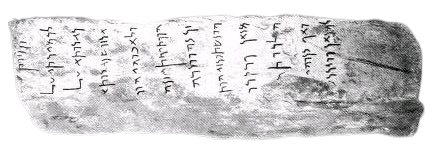There is a lot of confusion concerning the names used for the Aramaic language-Aramaic,Imperial Aramaic,Middle Aramaic,Jewish Aramaic,Galilean Aramaic,Syriac,Mandaic,Assyrian,Neo-Aramaic,Turoyo,Chaldean etc are some of the terms used for it.
To understand why all these names exist for Aramaic you must take into account that Aramaic was never a unified language.Since ancient times there were various dialects written in various scripts sometimes different enough to be separate languages from which others evolved.
Let's look at some of terms used for Aramaic one by one:
Aramaic-It is a cover term that includes all dialects in all phases of history ,from ancient times up to the modern day.It also refers mainly to the ancient version of the language (Old Aramaic).
Imperial Aramaic-the second official language of the Persian Empire of the Achaemenids.It was also the lingua franca of the Persian territories in the Middle East.
Galilean Aramaic -also know as Jewish Palestinian Aramaic.It was spoken mainly by Jews in Palestine.It is considered that this was the mother tongue of Jesus Christ.Extinct by 7 AD.
Jewish Aramaic-The language of the books of Ezra and Daniel.Also the language of the Talmud.
Syriac- It is a later version of Aramaic that evolved from Old Aramaic.It belongs to Middle Aramaic.It should not be confused with the word Syrian refering to the Arab dialect of Syria.
Mandaic-It is another dialect that sprung from Old Aramaic and it is the language of the Mandaean religion.
Neo-Aramaic-the descendent dialects of Aramaic that survived to the modern day spoken by Aramaic speaking enclaves in the Near East.
Turoyo-it one of the Neo-Aramaic dialects.
Assyrian-it is another Neo-Aramaic dialect.Not to be confused with the language of ancient Assyrians (Assyrobabylonian).
All of these terms can be simply referred to as Aramaic.
I hope this post made it somewhat clearer for you.
To understand why all these names exist for Aramaic you must take into account that Aramaic was never a unified language.Since ancient times there were various dialects written in various scripts sometimes different enough to be separate languages from which others evolved.
Let's look at some of terms used for Aramaic one by one:
Aramaic-It is a cover term that includes all dialects in all phases of history ,from ancient times up to the modern day.It also refers mainly to the ancient version of the language (Old Aramaic).
Imperial Aramaic-the second official language of the Persian Empire of the Achaemenids.It was also the lingua franca of the Persian territories in the Middle East.
Galilean Aramaic -also know as Jewish Palestinian Aramaic.It was spoken mainly by Jews in Palestine.It is considered that this was the mother tongue of Jesus Christ.Extinct by 7 AD.
Jewish Aramaic-The language of the books of Ezra and Daniel.Also the language of the Talmud.
Syriac- It is a later version of Aramaic that evolved from Old Aramaic.It belongs to Middle Aramaic.It should not be confused with the word Syrian refering to the Arab dialect of Syria.
Mandaic-It is another dialect that sprung from Old Aramaic and it is the language of the Mandaean religion.
Neo-Aramaic-the descendent dialects of Aramaic that survived to the modern day spoken by Aramaic speaking enclaves in the Near East.
Turoyo-it one of the Neo-Aramaic dialects.
Assyrian-it is another Neo-Aramaic dialect.Not to be confused with the language of ancient Assyrians (Assyrobabylonian).
All of these terms can be simply referred to as Aramaic.
I hope this post made it somewhat clearer for you.
